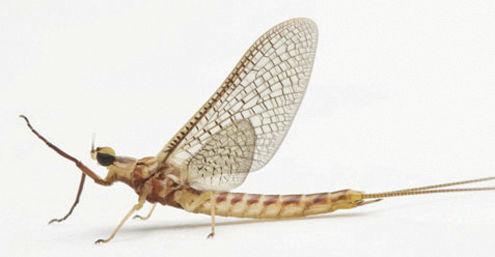There is one bug in the fly fishing world that anglers in the East wait all year long for the bug to hatch. This bug is one of the largest mayflies in the world. It runs in sizes up to 2 inches in length. This bug is … huge!
The bug is Hexagenia limbata — or hex for short.
When the hexes are hatching, it looks like little sailboats floating all over the water. Once you have seen the hex on the water, you will never forget what one looks like.
Hexes live in the silt at the bottom of ponds. Once they get ready to hatch, they swim slowly and weirdly to the surface. Once at the surface they molt, spread their wings, and once their wings are dry, take to the air to mate.
Another sight you will not soon forget. Hundreds of hex airborne on the pond. It is like great big snowflakes blowing in the wind. The trout haven’t forgotten what the hex mean. It is the last chance for them to feed on the surface before they retreat to the deeper, cooler environs of the pond. When you see the size of the rises, or better yet hear the rises, your head is on a swivel trying to decide which rise to cast to.
Not every pond has a hex hatch. Those ponds that do have the hatch are few and far between. And each season is different. Hexes can hatch early as mid-June or as late as mid-July. Those of us that seek the hex have our radar up early. Each day of the hex hatch that is missed means a missed opportunity.
This year, the first blip on my radar screen was just two weeks ago. A customer told me that they had seen hexes on Profile Lake in Franconia. Profile is one of the earlier ponds to have hex hatch. It is only an hour from the Valley so well worth the drive, to hit the hatch.
I headed over to see if the hex were hatching on Profile. Arriving about 7 p.m., I put the canoe in the lake and headed to the north end. There is a deep hole just off the beach at this end of Profile. A hole where the brook trout lay in wait for the hex to hatch.
Hexagenia are a nocturnal hatch. It is rare that you will see bugs before the approach of darkness. Being early to Profile, I quickly tied on a hex nymph pattern to the end of my sinking fly line. Since hex bring up the biggest fish, the leader was a 7 1/2- foot 3X leader.
Casting out toward the deep hole and counting to twenty, to let the fly sink, I did a slow return of the fly back to the canoe. Trout would grab the fly at various stages of retrieval. They were even hitting the fly as it sank.
This was a good omen. Trout hitting Hex nymphs meant that the hexes were active. Darkness descended upon the lake. But there were no rises. No hatching hexes. No hexes sailing down the pond. Would a hatch happen?
The Hex nymph kept drawing strikes and the fish got bigger as the sky got blacker. Soon it was too dark to see and to change the fly to a full dun pattern. And there were no hatching hexes. Paddling back to the canoe launch, I wondered, “had the hexes won again.”
When fishing popular hatches like the hex, be sure to allow sufficient spacing with other anglers who are there to enjoy the hatch with you.
Credit: Source link





























